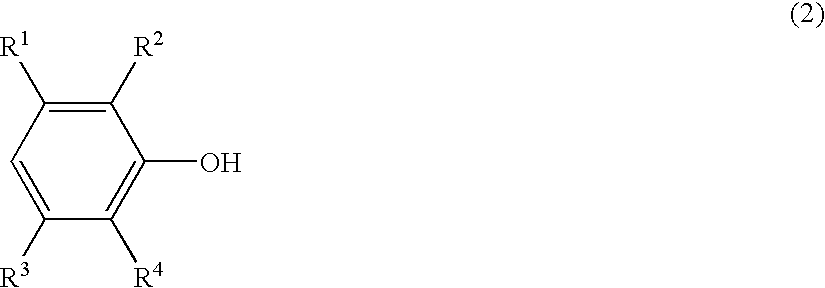Resin composition
a technology of composition and resin, applied in the field of resin composition, can solve the problems of insufficient heat resistance and dimensional stability, short-circuiting or wire breaking, and difficulty in reducing interlayer spacing, and achieve excellent mechanical properties, dimensional stability, heat resistance and flame retardancy.
- Summary
- Abstract
- Description
- Claims
- Application Information
AI Technical Summary
Benefits of technology
Problems solved by technology
Method used
Image
Examples
example 1
[0139] 100 parts by weight of a modified polyphenylene ether resin (product of Asahi Kasei Corp., ZYLON (PKL) X9102) as thermoplastic resin and 30 parts by weight of swelling fluorine mica (product of CO-OP Chemical Co., Ltd., SOMASIF MAE-100) organically modified with a distearyldimethyl quaternary ammonium salt, as a layer silicate, were fed into a compact-size extruder (product of Japan Steel Works, Ltd., TEX-30), melt kneaded at 290° C. and extruded into strands which were then pelletized by a pelletizer to provide a masterbatch. Next, 100 parts by weight of a polyimide resin (product of Mitsui Chemicals, Inc., AURUM PD-450) as a thermoplastic resin and 9.5 parts by weight of the above-obtained masterbatch were fed into a compact-size extruder (product of Japan Steel Works, Ltd., TEX-30), melt kneaded at 420° C. under a stream of nitrogen and extruded into strands which were subsequently pelletized by a pelletizer to provide pellets of the resin composition. The thus-obtained pe...
example 2
[0140] 100 parts by weight of a modified polyphenylene ether resin (product of Asahi Kasei Corp., ZYLON (PKL) X9102) as a thermoplastic resin and 30 parts by weight of swelling fluorine mica (product of CO-OP Chemical Co., Ltd., SOMASIF MAE-100) organically modified with a distearyldimethyl quaternary ammonium salt, as a layer silicate, were fed into a compact-size extruder (product of Japan Steel Works, Ltd., TEX-30), melt kneaded at 280° C. and extruded into strands which were then pelletized by a pelletizer to provide a masterbatch. Next, 100 parts by weight of polyether ether ketone as a thermoplastic resin and 9.5 parts by weight of the above-obtained masterbatch were fed into a compact-size extruder (product of Japan Steel Works, Ltd., TEX-30), melt kneaded at 400° C. under a stream of nitrogen and extruded into strands which were subsequently pelletized by a pelletizer to provide pellets of the resin composition. Thus-obtained pellets of the resin composition were placed unde...
example 3
[0141] Bis[4-(3-aminophenoxy)phenyl]sulfone, weighing 66.12 parts by weight, was introduced into a 500 ml separable flask to which 370 parts by weight of dewatered N-methylpyrrolidone was subsequently added. After an interior of the flask was replaced by nitrogen, the flask contents were stirred at 150 rpm for about 30 minutes. Next, 33.72 parts by weight of pyromellitic anhydride and 40 parts by weight of dewatered N-methylpyrrolidone were added to the flask contents which were subsequently stirred at 150 rpm for 1 hour. Then, 253.2 parts by weight of an N-methylpyrrolidone solution containing 7.9% synthetic hectorite (product of CO-OP Chemical Co., Ltd., LUCENTITE STN), 0.001 parts by weight of aniline and 40 parts by weight of dewatered N-methylpyrrolidone were added to the flask contents which were subsequently stirred at 600 rpm for 4 hours to obtain a clay-containing polyamic acid solution. The obtained polyamic acid solution was heated to a high temperature so that a most par...
PUM
| Property | Measurement | Unit |
|---|---|---|
| temperature | aaaaa | aaaaa |
| temperature | aaaaa | aaaaa |
| temperature | aaaaa | aaaaa |
Abstract
Description
Claims
Application Information
 Login to View More
Login to View More - R&D
- Intellectual Property
- Life Sciences
- Materials
- Tech Scout
- Unparalleled Data Quality
- Higher Quality Content
- 60% Fewer Hallucinations
Browse by: Latest US Patents, China's latest patents, Technical Efficacy Thesaurus, Application Domain, Technology Topic, Popular Technical Reports.
© 2025 PatSnap. All rights reserved.Legal|Privacy policy|Modern Slavery Act Transparency Statement|Sitemap|About US| Contact US: help@patsnap.com

